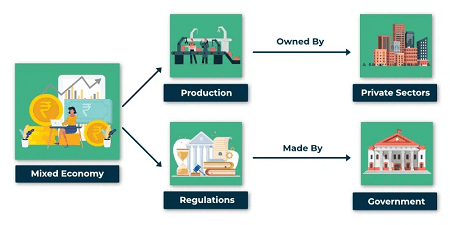Mixed economy-
A mixed economy is an economic system that combines elements of both capitalism and socialism. In a mixed economy, the means of production are owned and controlled both by private individuals and by the government. This system seeks to incorporate the advantages of both capitalism (such as private enterprise, market mechanisms, and incentives for innovation) and socialism (such as social welfare programs, public ownership of key industries, and government intervention to correct market failures).
Key features of a mixed economy typically include:
- Private Ownership: Individuals and private firms can own and control property, businesses, and resources. This allows for competition, entrepreneurship, and innovation.
- Government Intervention: The government plays a significant role in regulating and guiding economic activity. It may provide public goods and services, such as education, healthcare, infrastructure, and national defense. Additionally, it may intervene to correct market failures, such as monopolies, externalities, and inadequate provision of public goods.
- Market Mechanisms: Prices are determined by supply and demand in markets, allowing for efficient allocation of resources in many sectors of the economy. Competition between firms helps drive efficiency and innovation.
- Social Programs: There are typically social safety nets and welfare programs aimed at providing assistance to those in need, such as unemployment benefits, healthcare subsidies, and pensions.
- Mixed Ownership of Industry: While private ownership predominates, the government may own or control certain industries or sectors that are considered essential for public welfare or national security.
Examples of countries with mixed economies include the United States, Canada, most Western European nations, Australia, and Japan. The exact balance between market forces and government intervention can vary widely among these countries, leading to different degrees of economic regulation and social welfare provision.
What is Required Mixed economy
A Required Mixed Economy is a theoretical concept that emphasizes the necessity of combining elements of both capitalism and socialism in an economy to achieve certain social and economic goals. Here’s a breakdown of what a Required Mixed Economy entails:
- Prescribed Balance of Capitalism and Socialism: Unlike a traditional mixed economy where the balance between capitalism (private ownership and market forces) and socialism (government intervention and social welfare programs) can vary, a Required Mixed Economy suggests a specific and deliberate balance that is deemed necessary or optimal for achieving particular outcomes.
- Focus on Social Goals: The emphasis is on using the mixed economy framework not just for economic efficiency or growth, but explicitly for achieving social objectives such as reducing inequality, ensuring social justice, promoting sustainable development, or addressing specific societal needs.
- Government Mandates and Directives: In a Required Mixed Economy, the government plays a proactive role in mandating or directing the allocation of resources and the operation of industries to ensure that societal goals are met. This could involve targeted investment in certain sectors (like healthcare or education), regulations to protect the environment, or policies to ensure fair wages and labor rights.
- Integration of Economic and Social Policies: Economic policies are closely integrated with social policies to create a cohesive strategy for overall societal well-being. This integration might include comprehensive social safety nets, universal healthcare, subsidized education, housing programs, and other forms of social support alongside market-oriented economic activities.
- Dynamic Adjustment: The concept acknowledges that the balance between capitalism and socialism may need to be dynamically adjusted over time in response to changing societal needs, economic conditions, technological advancements, and global trends.
While the idea of a Required Mixed Economy is more of a theoretical construct than a precise economic model implemented in practice, it reflects the recognition that purely capitalist or socialist systems may not adequately address all dimensions of human welfare and societal development. Instead, it suggests that a deliberate and balanced approach combining market mechanisms with government intervention and social policies could better serve the broader interests of society.
Who is Required Mixed economy
“Required Mixed Economy” isn’t a person; rather, it appears to be a misinterpretation or a miscommunication of the concept of a mixed economy.
A mixed economy refers to an economic system that combines elements of both capitalism and socialism. It’s a theoretical and practical framework where private enterprise and market mechanisms coexist with government intervention and regulation. This combination is aimed at achieving economic growth, while also addressing social needs and ensuring a level playing field.
If you’re asking about a specific person or entity named “Required Mixed Economy,” there doesn’t appear to be such a figure or organization. However, if you meant something else or have a specific aspect of mixed economies you’d like to explore, please clarify and I’d be happy to provide more information!
When is Required Mixed economy
A mixed economy exists in many countries around the world today. It is not tied to a specific time period but rather describes an ongoing economic system that combines elements of both capitalism and socialism. Here are some key points about when and where mixed economies are typically found:
- Geographical Spread: Mixed economies are prevalent in many developed and developing countries across various continents. Examples include the United States, Canada, most European countries, Australia, Japan, South Korea, Brazil, and India.
- Historical Development: The concept of mixed economies has evolved over time as societies have sought to balance the advantages of free markets (such as innovation and efficiency) with the need for government intervention to address market failures, income inequality, and societal welfare.
- Reasons for Adoption: Mixed economies are adopted to achieve multiple objectives:
- Efficiency: Allow market forces to allocate resources and drive economic growth.
- Equity: Ensure fairness and reduce income inequality through social welfare programs, progressive taxation, and regulations.
- Stability: Mitigate economic instability through government interventions, such as fiscal and monetary policies.
- Social Welfare: Provide essential public services like healthcare, education, and infrastructure.
- Flexibility: The balance between capitalist and socialist elements in a mixed economy can vary. Some countries lean more towards capitalism with minimal government intervention (e.g., United States), while others have stronger socialist influences with extensive welfare systems and state-owned enterprises (e.g., Scandinavian countries).
- Adaptation to Change: Mixed economies evolve over time in response to changing economic conditions, technological advancements, social priorities, and political ideologies.
In summary, a mixed economy is not tied to a specific time frame but rather describes a contemporary economic system found in numerous countries today. It represents a synthesis of market-based principles and government intervention aimed at achieving both economic growth and societal welfare.
Where is Required Mixed economy

It seems there might still be some confusion regarding the term “Required Mixed Economy.” As previously mentioned, “Required Mixed Economy” isn’t a recognized term in economics or political science. If you’re asking about where mixed economies are found or implemented, they exist in various countries around the world. Here are some examples:
- United States: Often cited as having a predominantly capitalist economy with significant government intervention in certain sectors (such as healthcare and education) and social safety nets.
- Canada: Features a mixed economy with strong government involvement in healthcare, education, and social welfare programs, alongside a market-driven private sector.
- Western European Countries (e.g., Germany, France, Sweden): Known for their mixed economies that combine extensive social welfare systems, regulated markets, and private enterprise.
- Australia: Operates with a mixed economy characterized by a competitive private sector, government regulation in areas like healthcare and education, and robust social safety nets.
- Japan: Combines a market-oriented economy with government support and regulation in key industries, such as technology and manufacturing.
- Scandinavian Countries (e.g., Denmark, Norway, Sweden): Often regarded as having strong social welfare states alongside capitalist economies, with high levels of taxation to fund comprehensive public services and income redistribution.
In these countries and many others, the specific balance between capitalist and socialist elements varies, reflecting historical, cultural, and political factors. The goal of a mixed economy is generally to harness the strengths of both market mechanisms (such as innovation and efficiency) and government intervention (such as social equity and stability) to achieve overall economic prosperity and social well-being.
If you have a different context or specific aspect of mixed economies you’re interested in, please feel free to provide more details so I can assist you further.
How is Required Mixed economy
It seems there may still be confusion regarding the term “Required Mixed Economy.” As mentioned earlier, this term does not correspond to any standard economic or political concept. However, if you’re asking about how a mixed economy operates or functions, I can certainly explain that.
A mixed economy combines elements of both capitalism and socialism, aiming to blend the advantages of market efficiency with the social welfare goals typically associated with government intervention. Here’s how a mixed economy generally operates:
- Private Ownership and Market Mechanisms: In a mixed economy, private individuals and businesses own and control a significant portion of the means of production and resources. Market forces of supply and demand largely determine prices, production levels, and allocation of goods and services.
- Government Intervention: The government plays a crucial role in regulating economic activities to ensure fair competition, consumer protection, and environmental sustainability. It also provides public goods and services that may be under-provided by the market, such as infrastructure, national defense, and basic education.
- Social Welfare Programs: Mixed economies typically include social safety nets and welfare programs aimed at promoting social equity and supporting those in need. These may include unemployment benefits, healthcare systems, public pensions, and education subsidies.
- Redistribution of Wealth: Through taxation and social spending, mixed economies redistribute wealth to address income inequality and ensure a certain standard of living for all citizens. Progressive taxation is often used to fund social programs and infrastructure development.
- Regulation and Oversight: Governments in mixed economies enact regulations to protect consumers, workers, and the environment. These regulations aim to prevent market failures, such as monopolies, externalities (like pollution), and unfair labor practices.
- Public-Private Partnerships: Mixed economies may also involve collaborations between the public and private sectors to achieve common goals, such as infrastructure projects, healthcare delivery, and technology development.
- Flexibility and Adaptability: The balance between market forces and government intervention can vary over time and across different sectors of the economy, depending on changing economic conditions, political priorities, and societal needs.
Overall, the key characteristic of a mixed economy is its attempt to strike a balance between the efficiency and innovation fostered by competitive markets and the social welfare goals addressed through government intervention and regulation. This balance can vary significantly among countries and can evolve over time in response to economic, social, and political developments.
Case Study on Mixed economy
A case study on a mixed economy could focus on a country that exemplifies the principles and challenges associated with balancing capitalist and socialist elements in its economic system. Let’s take Germany as an example:
Case Study: Germany’s Mixed Economy
Overview:
Germany operates under a mixed economy framework, blending market-oriented principles with significant government intervention and social welfare programs. This approach has evolved over time and is shaped by historical, political, and cultural factors.
Key Features:
- Social Market Economy: Germany follows the concept of a “social market economy,” which emphasizes a competitive market economy combined with strong social policies and welfare programs to ensure social justice and economic stability.
- Private Sector: The private sector plays a crucial role in Germany’s economy, with a diverse range of industries and companies, including globally competitive firms in manufacturing, automotive, technology, and finance.
- Government Intervention: The German government intervenes in the economy through various means:
- Regulation: Strict regulations ensure fair competition, consumer protection, and environmental sustainability.
- Public Services: The government provides extensive public services such as healthcare, education, transportation infrastructure, and social housing.
- Labor Market Policies: Policies promote workers’ rights, vocational training, and job security, contributing to a skilled workforce and labor market stability.
- Social Welfare: Germany has a comprehensive welfare state that includes:
- Healthcare: Universal health insurance coverage ensures access to quality healthcare services.
- Education: Free or highly subsidized education from primary to university level promotes equal opportunities.
- Social Security: Generous social security benefits, including unemployment benefits, pensions, and family support programs, protect citizens against economic risks.
- Industrial Policy: The government actively supports key industries and sectors through:
- Research and Development: Investment in innovation and technology to maintain competitiveness.
- Industrial Strategies: Policies to promote export-oriented manufacturing, sustainable energy, and digital transformation.
Challenges:
- Demographic Shifts: Germany faces challenges related to an aging population and declining workforce, which puts pressure on pension systems and healthcare financing.
- Globalization: Integration into global markets requires balancing economic openness with protecting domestic industries and workers.
- Income Inequality: Despite social welfare programs, income inequality persists, with disparities between regions and socioeconomic groups.
- Environmental Sustainability: Transitioning to a low-carbon economy while maintaining economic growth poses challenges in terms of energy policy and industrial restructuring.
Conclusion:
Germany’s mixed economy illustrates how a balance between market forces and government intervention can foster economic stability, innovation, and social welfare. By leveraging the strengths of both capitalism and socialism, Germany has built a resilient economy that navigates global challenges while maintaining a high standard of living and social cohesion. However, ongoing adaptation and policy adjustments are essential to address emerging challenges and ensure sustainable economic development.
This case study highlights the complexities and dynamics of managing a mixed economy in a globalized world, offering valuable insights for policymakers and economists worldwide.
White paper on Mixed economy
Writing a white paper on a mixed economy would involve exploring its principles, advantages, challenges, and real-world applications. Here’s an outline you could use to structure such a document:
Title: Understanding the Mixed Economy: Principles, Advantages, and Challenges
1. Introduction
- Definition and overview of a mixed economy.
- Importance of studying mixed economies in contemporary economic theory and practice.
2. Historical Context
- Origins and development of mixed economies.
- Evolution from pure capitalism and socialism to mixed models.
3. Principles of a Mixed Economy
- Balancing market forces and government intervention.
- Role of private sector entrepreneurship and innovation.
- Government’s role in regulation, public services, and social welfare.
4. Advantages of a Mixed Economy
- Economic efficiency and innovation fostered by market mechanisms.
- Social equity and welfare through government intervention.
- Flexibility to address market failures and social needs simultaneously.
5. Key Features of Mixed Economies
- Private ownership vs. state ownership.
- Market competition and regulation.
- Social safety nets and welfare programs.
6. Case Studies
- Examples of countries with successful mixed economies (e.g., Germany, Sweden, Canada).
- Comparison of mixed economy models and their outcomes.
7. Challenges and Criticisms
- Income inequality and wealth disparity.
- Balancing economic growth with environmental sustainability.
- Political challenges and policy implementation issues.
8. Future Directions
- Innovations in mixed economy models.
- Adapting to globalization and technological advancements.
- Sustainability and inclusive growth strategies.
9. Conclusion
- Summary of key findings and insights.
- Importance of maintaining a balanced approach in economic policy-making.
- Recommendations for policymakers, businesses, and stakeholders.
10. References
- List of sources and citations used in the white paper.
Writing Tips:
- Clear Structure: Ensure each section flows logically from one to the next, building a comprehensive understanding of mixed economies.
- Evidence-Based: Support claims and arguments with data, case studies, and examples to enhance credibility.
- Accessible Language: Write in a clear, jargon-free manner to make the content understandable to a wide audience.
- Visual Aids: Consider using charts, graphs, and tables to illustrate key points and data.
- Policy Recommendations: Provide actionable insights and recommendations based on your analysis.
By following this outline and incorporating thorough research and analysis, you can create a comprehensive white paper that explores the concept of a mixed economy in depth, offering valuable insights into its principles, applications, and future challenges.
Industrial Application of Mixed economy
The industrial application of a mixed economy involves how the principles of both capitalism and socialism are applied in the context of industrial production and economic development. Here’s an exploration of how mixed economy principles are applied in industry:
1. Private Sector Innovation and Investment:
- Entrepreneurship and Innovation: In a mixed economy, the private sector plays a crucial role in driving industrial innovation. Private businesses have the freedom to innovate, develop new technologies, and bring products to market based on consumer demand and competitive pressures.
- Investment: Private enterprises have access to capital markets to fund industrial projects, expand production capacities, and invest in research and development (R&D). This fosters competitiveness and efficiency in industrial sectors.
2. Government Regulation and Support:
- Regulatory Framework: Governments in mixed economies regulate industrial activities to ensure fair competition, consumer protection, worker safety, and environmental sustainability. Regulations may cover aspects like emissions standards, workplace conditions, product safety, and corporate governance.
- Support for Strategic Industries: Governments often provide support, incentives, and subsidies to strategic industries deemed critical for national development or security. This may include sectors like aerospace, defense, energy, and high technology where government involvement aims to stimulate growth, enhance competitiveness, and promote innovation.
3. Infrastructure Development:
- Public Investment: Mixed economies prioritize public investment in infrastructure such as transportation networks, communication systems, energy grids, and water management. These investments create a foundation for industrial development, reducing logistical costs, and enhancing connectivity between industrial centers and markets.
- Public-Private Partnerships (PPPs): Governments may collaborate with private firms through PPPs to finance and develop large-scale infrastructure projects. This partnership allows for sharing risks and leveraging private sector expertise while ensuring public oversight and accountability.
4. Social Welfare and Labor Policies:
- Labor Rights and Welfare: Mixed economies enforce labor laws that protect workers’ rights, ensure fair wages, and promote workplace safety. Social welfare policies, including healthcare, education, and pension systems, support the workforce, enhancing productivity and industrial stability.
- Training and Skills Development: Governments may invest in vocational training programs and educational initiatives to equip the workforce with skills relevant to evolving industrial needs. This fosters a skilled labor force capable of driving industrial innovation and competitiveness.
5. Economic Stabilization and Resilience:
- Counteracting Market Volatility: Mixed economies employ fiscal and monetary policies to stabilize industrial sectors during economic downturns. Government intervention may include stimulus packages, tax incentives, and monetary easing to mitigate the impact of external shocks on industrial output and employment.
- Diversification Strategies: Governments promote industrial diversification to reduce reliance on specific sectors or markets vulnerable to fluctuations. This strategy encourages balanced economic growth, enhances resilience, and expands opportunities for industrial development across multiple sectors.
Case Example: Germany’s Industrial Policy
- Germany exemplifies how a mixed economy approach supports industrial development. The country combines a strong private sector (e.g., automotive, engineering) with robust government support and regulation. Policies include investment in high-tech manufacturing, vocational training, renewable energy, and infrastructure. This balanced approach fosters innovation, competitiveness, and sustainable industrial growth while ensuring social welfare and environmental protection.
In conclusion, the industrial application of a mixed economy leverages the strengths of both market mechanisms and government intervention to foster industrial innovation, competitiveness, and sustainable development. By balancing private sector dynamism with public sector oversight and support, mixed economies aim to achieve economic growth while addressing societal needs and challenges.





